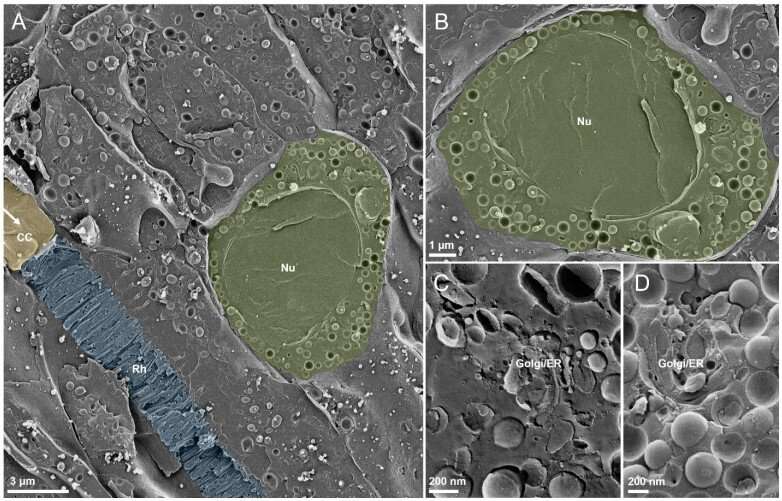Prawn larvae found to hide their dark eyes with a light-manipulating material

A team of researchers from Ben-Gurion University of the Negev, the University of Cambridge, the Interuniversity Institute for Marine Sciences and the Indian Institute of Technology Kanpur reports that transparent prawn larvae (and many other sea creatures) camouflage their dark eyes with a light-manipulating material to reflect colors in the surrounding water.
The group has published a paper describing their close-up analysis of eyeshine reflectors in multiple larval crustaceans in the journal Science. Kate Feller and Megan Porter with Union College in New York have published a Perspective piece in the same journal issue outlining the work by the team.
Many larval creatures that live in the sea are nearly completely transparent, making it difficult for predators to find and eat them. However, the eyes cannot be transparent, as dark pigment is required. In this new effort, the marine scientists have discovered that the creatures have evolved a workaround for this problem—eyeshine reflectors.
Eyeshine reflectors, as their name implies, reflect some of the light before it enters the eyes. They do not need to reflect all of the spectrum; only the colors that exist in the surrounding environment. Thus, if a larval prawn lives in greenish water, reflecting shades of green should be sufficient to hide the eyes from local predators.
For this new study, the researchers took a closer look at the eyeshine reflectors of Machrobrachium rosenbergi, a type of freshwater prawn. To learn about its composition, the group used a scanning electron microscope and other optical devices to get a look at the reflector on a cellular level.
They found that it was made up of mostly highly reflective cells that contained a photonic glass in the form of crystalline isoxanthopterin nanospheres. This arrangement, the research team noted, made the reflectors tunable to some degree. Thus, larvae living in blueish water had slightly different crystal arrangements in their eye covers than did those living in greenish water.
More information:
Keshet Shavit et al, A tunable reflector enabling crustaceans to see but not be seen, Science (2023). DOI: 10.1126/science.add4099
Kate Feller et al, Photonic tinkering in the open ocean, Science (2023). DOI: 10.1126/science.adf2062
© 2023 Science X Network
Citation:
Prawn larvae found to hide their dark eyes with a light-manipulating material (2023, February 17)
retrieved 17 February 2023
from https://phys.org/news/2023-02-prawn-larvae-dark-eyes-light-manipulating.html
This document is subject to copyright. Apart from any fair dealing for the purpose of private study or research, no
part may be reproduced without the written permission. The content is provided for information purposes only.
For all the latest Science News Click Here
For the latest news and updates, follow us on Google News.

